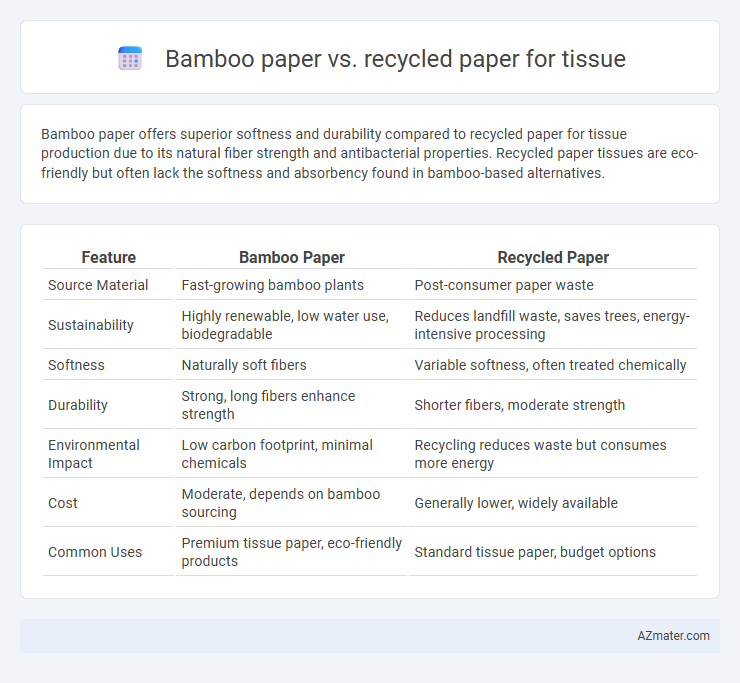Bamboo paper offers superior softness and durability compared to recycled paper for tissue production due to its natural fiber strength and antibacterial properties. Recycled paper tissues are eco-friendly but often lack the softness and absorbency found in bamboo-based alternatives.
Table of Comparison
| Feature | Bamboo Paper | Recycled Paper |
|---|---|---|
| Source Material | Fast-growing bamboo plants | Post-consumer paper waste |
| Sustainability | Highly renewable, low water use, biodegradable | Reduces landfill waste, saves trees, energy-intensive processing |
| Softness | Naturally soft fibers | Variable softness, often treated chemically |
| Durability | Strong, long fibers enhance strength | Shorter fibers, moderate strength |
| Environmental Impact | Low carbon footprint, minimal chemicals | Recycling reduces waste but consumes more energy |
| Cost | Moderate, depends on bamboo sourcing | Generally lower, widely available |
| Common Uses | Premium tissue paper, eco-friendly products | Standard tissue paper, budget options |
Introduction to Tissue Paper Materials
Bamboo paper offers a sustainable alternative to traditional tissue materials due to its rapid growth rate and natural antibacterial properties, making it highly eco-friendly and durable for tissue production. Recycled paper tissue utilizes post-consumer waste fibers, reducing deforestation impact but sometimes resulting in a coarser texture and lower strength compared to bamboo-based tissue. Both materials contribute to environmental conservation, with bamboo tissue favored for softness and longevity, while recycled paper supports waste reduction through fiber reprocessing.
What is Bamboo Paper?
Bamboo paper is a sustainable tissue product made from bamboo fibers, known for its rapid growth and minimal use of pesticides compared to traditional wood pulp sources. Its natural antibacterial properties and high tensile strength make bamboo paper ideal for tissue applications that require softness and durability. Bamboo paper production also significantly reduces deforestation and water consumption, positioning it as an eco-friendly alternative to recycled paper.
What is Recycled Paper?
Recycled paper for tissue is produced by reprocessing used paper materials, such as office paper, cardboard, and newspapers, to create new paper products, reducing the demand for virgin pulp and saving natural resources. It often contains a blend of fibers that may result in lower softness and strength compared to bamboo paper, but it significantly minimizes landfill waste and energy consumption during manufacturing. The environmental benefits of recycled paper include lower greenhouse gas emissions and reduced deforestation, making it a sustainable choice for tissue production.
Environmental Impact: Bamboo vs Recycled Paper
Bamboo paper offers a lower environmental impact than recycled paper due to its rapid growth rate, requiring less water and pesticides while capturing more carbon dioxide during cultivation. In contrast, recycled tissue paper reduces waste by repurposing existing fibers, though repeated recycling can weaken fiber quality, leading to increased energy and chemical usage in processing. Both options promote sustainability, but bamboo tissue paper's renewable nature and faster biomass replenishment contribute to a smaller carbon footprint compared to conventional recycled paper.
Manufacturing Process Comparison
Bamboo paper manufacturing involves harvesting fast-growing bamboo stalks, which are mechanically processed and chemically treated to produce soft fibers with minimal water and energy consumption compared to traditional methods. Recycled paper production relies on collecting, sorting, and re-pulping used paper materials, which requires extensive deinking and bleaching to remove contaminants and restore fiber quality, often leading to higher chemical usage and wastewater generation. Bamboo's renewable growth cycle and lower processing impact position it as a more sustainable raw material than recycled fibers, which depend on existing paper waste streams and involve more complex purification steps.
Softness and Texture Differences
Bamboo paper for tissue offers superior softness and a naturally smooth texture due to its long, fine fibers, making it gentle on sensitive skin compared to recycled paper. Recycled paper tissues tend to have a coarser texture and lower softness because the fibers are shorter and often processed multiple times, which can reduce overall quality. The natural composition of bamboo fibers enhances absorbency and pliability, providing a more luxurious and comfortable tissue experience.
Absorbency and Strength
Bamboo paper exhibits superior absorbency and strength compared to recycled paper due to its long, strong fibers that enhance liquid retention and durability. Bamboo fibers naturally contain an antimicrobial agent called bamboo kun, contributing to hygiene without compromising paper thickness or softness. Recycled paper often has shorter fibers, which reduces both absorbency and tensile strength, making bamboo paper a more efficient and resilient choice for tissue products.
Cost and Accessibility
Bamboo paper for tissue generally has higher production costs due to the specialized processing required, while recycled paper is often more cost-effective because it utilizes existing paper waste. Bamboo tissue offers superior softness and durability, but its accessibility is limited by fewer suppliers and regional availability compared to widely available recycled paper. Price sensitivity in the tissue market often favors recycled options despite bamboo's environmental benefits, influencing consumer and manufacturer preferences.
Sustainability and Certifications
Bamboo paper offers superior sustainability due to its rapid growth and minimal pesticide requirements, making it a renewable resource compared to recycled paper, which relies on post-consumer waste that can vary in availability and quality. Bamboo paper often holds certifications like FSC (Forest Stewardship Council) and Ecolabel, ensuring responsible forestry and environmental standards, while recycled paper may carry certifications such as Green Seal or EPA's Recycled Content Certification to verify its eco-friendly recycled content. The environmental impact of bamboo paper is generally lower in water and chemical usage, whereas recycled paper reduces landfill waste and conserves existing fiber resources, making each choice viable depending on specific ecological priorities.
Which is Better: Bamboo or Recycled Tissue Paper?
Bamboo tissue paper outperforms recycled tissue paper in sustainability due to bamboo's rapid growth and minimal water usage, making it a renewable resource with a lower environmental impact. Recycled tissue paper reduces waste by repurposing used materials but may involve chemical processing that affects softness and strength. Bamboo tissue offers superior softness, strength, and eco-friendliness, positioning it as a better choice for environmentally conscious consumers.

Infographic: Bamboo paper vs Recycled paper for Tissue
 azmater.com
azmater.com